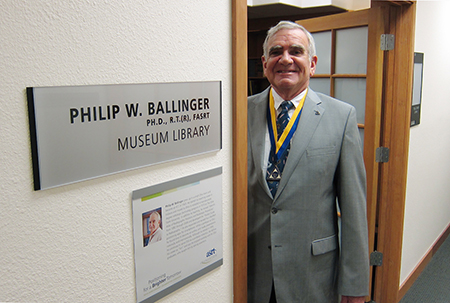Aug. 31, 2015
 Radiography and education proved a stronger pull than an engineering degree to one small-town boy with a penchant for humor and scholarship. Although it might have thrown Phil Ballinger’s parents off when their son left a pre-engineering program at Wilmington College to attend x-ray school, their wish for him to earn his degree would have to wait.
Radiography and education proved a stronger pull than an engineering degree to one small-town boy with a penchant for humor and scholarship. Although it might have thrown Phil Ballinger’s parents off when their son left a pre-engineering program at Wilmington College to attend x-ray school, their wish for him to earn his degree would have to wait.
His lifetime commitment to this profession started with a promotional brochure Ballinger picked up in his college library that featured a hospital certificate program for “x-ray technicians.”
Phil worked in a factory that summer in 1961, but found the time to fill out an application for the hospital program as he waited for college to start again. “I knew engineering was not for me after a year of math, surveying, construction details and being stuck working alone over a drafting table with little interaction with people. Radiography sounded intriguing.”
A Growing Fascination
Two weeks before returning for his sophomore year at Wilmington, he was accepted into an “x-ray technician” program that would start the following January. During that hiatus from school, the family businesses and other work kept him busy.
“I lived at home in West Mansfield, Ohio (population of 700 and one traffic light), worked on the farm, helped lay carpet and flooring and worked in the family Ballinger Funeral Home. After graduating and achieving my R.T. credential, I began taking x-rays in January of 1964.”
Throughout this detour from college, his parents continued to dream that their son would return to college to earn a bachelor’s degree. Phil also sought to return to school, but faced an obstacle that many others with the same goal experienced.
“I could not find any college or university that would grant me any academic credit for my two years of radiography education, my R.T. certification or working in a hospital producing x-rays as life experience.”
Phil worked in radiography at night and on weekends while earning a bachelor of arts in biology and chemistry. Since he had already put in two years for his certification, he calls this his “seven-year education plan.”
Advancing on Education by Degrees
After earning his bachelor’s degree, Phil accepted his first full-time instructional job at Reid Memorial Hospital in Richmond, Indiana. “I learned far more at Reid than what I learned in my previous seven years of college and radiography. The Reid program was, and remains, a superb radiography program.”
He also met and married his wife of 45 years, Nancy, during his time at Reid.
His educational experiences eventually led Phil to address the issue of accepting credits from two-year programs after starting at The Ohio State University (OSU) in 1970. “I appreciated the time people took to teach me in the hospital, and I thought, ‘I want to do the same.’ I appreciated that someone took the time to show me how to produce high-quality images.” He developed one of the earliest radiography bachelor's degree programs in the United States to accept credits from hospital-based certificate programs.
While teaching at OSU, Phil completed his master’s degree and gained a son, Eric, and a daughter, Monica. He and his wife now have two grandchildren who further expanded the family.
Building on His Radiography Knowledge
In 1976, a review copy of the fourth edition of Merrill’s Atlas of Roentgenographic Positions and Standard Radiographic Positions offered Phil a new challenge. He wrote a letter of constructive criticism to the publisher that cited the edition’s weaknesses, and a few years later he was asked by the publisher to revise Merrill’s Atlas. At that time, Phil took a four-month, unpaid leave of absence from OSU to coordinate, manage and revise the textbook. His efforts resulted in an internationally renowned edition of Merrill’s Atlas.
Phil transitioned from the Merrill’s Atlas revision project to authoring the 1989 Pocket Guide to Radiography, currently in its 13th edition. Phil has also flipped five houses and written five iRadTech apps for iPhone and Android smartphones for radiographic positioning (in English and Spanish), a chiropractic positioning app and, just for fun, the X-rayWOW app.
In 1995, OSU offered Phil an early retirement buyout and the title of professor emeritus. Twenty-seven days following retirement, he experienced a stroke that paralyzed his right arm and leg, and he could not speak for four days. He recovered his speech and continues to speak across the U.S. and internationally. He also earned a Ph.D. in educational administration.
Granted, our “Dr. Phil” has built a reputation as an educator, risk taker and humorist, along with someone who helps radiologic technologist educators to follow their dreams. Now he wants to ensure that others continue to learn, laugh and contribute to the profession he has championed since the space age. Today, his passion for the profession extends to funding the Philip W. Ballinger Endowed Scholarship and the ASRT library named in his honor.
“I recall the long hours and work involved in returning to college and hope to be able to assist others in achieving their career goals,” says Phil.